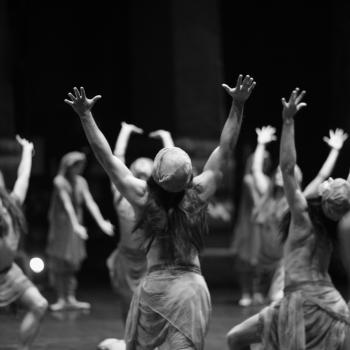 A lot of science happens when scientists are alone. There are the late nights coding data in the lab, with only the clack of the keys for company. There are solo evening walks when, if you’re lucky, a new hypothesis jumps suddenly to mind. But make no mistake – science doesn’t happen in a vacuum. All scientists need communities of fellow thinkers and experimentalists. Earlier this month, I had the pleasure of taking part in just such a community, when the International Association for the Cognitive Science of Religion (IACSR) met in Boston. It was a veritable cavalcade of scholars, with psychologists, anthropologists, and cognitive scientists gathering from all over the world to rub elbows, deliver presentations, and talk shop over four days in a hotel ballroom overlooking the Charles River.
A lot of science happens when scientists are alone. There are the late nights coding data in the lab, with only the clack of the keys for company. There are solo evening walks when, if you’re lucky, a new hypothesis jumps suddenly to mind. But make no mistake – science doesn’t happen in a vacuum. All scientists need communities of fellow thinkers and experimentalists. Earlier this month, I had the pleasure of taking part in just such a community, when the International Association for the Cognitive Science of Religion (IACSR) met in Boston. It was a veritable cavalcade of scholars, with psychologists, anthropologists, and cognitive scientists gathering from all over the world to rub elbows, deliver presentations, and talk shop over four days in a hotel ballroom overlooking the Charles River.
I’m actually playing a little fast and loose with the facts. The conference didn’t happen in Boston. It happened just across the river in Cambridge, on the 16th floor of the Hyatt Regency.* (There isn’t a better view of the Boston skyline.) But all of us lucky attendees did get to see each other’s presentations, share research results, and network like mad.
(Before I say any more, let me qualify that comment about networking. That term, “networking,” generally comes with a connotation of dreary obligation – something professional people have to do in order to scramble their way up the ladder of success toward, I don’t know, death. But networking at the IACSR meeting isn’t like that at all. How you network at IACSR is, you find people who are working on a really cool thing that’s relevant to the really cool thing you’re working on, and then everyone gets giddily excited to have found someone to talk with about this topic that no one in their respective daily lives cares one iota about. Then you spend all of the lunch hour happily swapping ideas, spitballing experimental designs, and recommending recent papers for the others to read. A year and a half later, a co-authored paper is forthcoming.
This is really the best thing about scientific conferences, and the reason they play such a central role in scientific life. Scientists of all kinds are oddities: we tend to study very narrow slices of the great big mess we call “reality,” and there aren’t very many of us, relative to the population. This means that any given city or university can only support, at the most, a single handful of specialists in any given sub-discipline. So your only chance to meet up in person with the few dozen other people in the world who are fanatically excited about the same thing as you is to go to conferences, where everyone flies in from around the planet to a single location and happily pays far too much for drinks.**)
I won’t try to give a play-by-play of the whole conference. But it’s worth pointing up some of the more fascinating research that was on display. One of the highlights was the very first panel, which focused on incorporating gender into scientific approaches to religion. Gender studies can sometimes be a politically dicey field, and unfortunately human evolutionary biology and cognitive science don’t always find a welcome reception among gender theorists – or vice-versa. But this panel, featuring one talk by Kate Stockly and another by Kayla Bonnin (both of Boston University), managed to walk the line between cultural and biological approaches to gender with aplomb. Stocky’s presentation surveyed atheism among women, offering new theoretic tools for investigating why men tend to be more likely to be atheists. Her talk was richly informed by the latest in both biological and cultural research into the underpinnings of gender, and refused to take sides in the “nature-vs.-nurture” debate. If more investigations into the roots of gender were so balanced, academic culture – and maybe regular culture too – would be in better shape, or at least more interesting.
Bonnin’s bracing talk, meanwhile, examined the differing reasons why women become religious suicide bombers, drawing on psychological theories of group fusion and devoted actors. Her research found that women are often radicalized in the wake of serious family tragedies or frustrated life ambitions having to do with the expected cultural roles in their society. For example, women in some extremely conservative Islamic societies sometimes become radicalized after suffering rape, because women who have been raped are unclean, and no longer eligible for marriage. Shut out from the only normative role open to females, such women can become more susceptible to religious radicalism. Other women sometimes become radicalized because their career ambitions are incompatible with the culturally normative wife-and-mother role. In both cases, suicide bombing is a culturally acceptable – even valorized – way out from a impossible situation. Importantly, this trajectory differs from men, for whom the major risk factors for radicalization include having a group of radicalized peer friends. For men, life tragedies don’t play as central a role in deciding to become a suicide bomber.
Bonnin’s fascinating presentation of some very ugly facts drew together the best of gender theory, which focuses on the cultural construction of gender roles (almost always through a critical lens), with biological and evolutionary approaches to sex and gender, which examine the different strategic challenges males and females face in mating and survival. As I said above, this is a really tough line to walk, but Bonnin’s talk showed that it can be done.
Another cool presentation came later on that day when Peter Maňo, a doctoral student at Comenius University in Bratislava, reported on a fascinating study of the yearly Tamil Hindu religious festival called Thaipusam. This festival features an extreme ritual, kavadi, in which participants carry heavy decorations for miles or pierce their skin with iron hooks or bars.
Recent cognitive and evolutionary explanations of extreme rituals have often focused on costly signaling, or the idea that people take part in challenging religious rituals in order to credibly signal their commitment to their in-group. In other words, Hindu believers carry heavy kavadi decorations or puncture their cheeks with iron implements in order to prove that they’re really committed to cooperating with other group members. Costly signaling theories of religious ritual often focus on general group norms, sometimes downplaying differences between different members of the group. But Maňo’s work, conducted in the island nation of Mauritius alongside a team led by Dimitris Xygalatas of the University of Connecticut, found that people of different social classes actually behaved differently in the Thaipusam.
Specifically, lower-status Tamil Mauritians were much more likely to carry large, heavy kavadi decorations, and on average used many more piercings, than their high-status countrymen. Indeed, high-status subjects were much less likely to participate in the kavadi ritual at all, and spent less time preparing for the ritual when they did. However, participants who were wealthier but not necessarily high-status (such as tradesmen with high incomes but no college educations) tended to carry larger – but not heavier – decorations. This finding suggested that they might be subtly “cheating,” or trying to appear as though they were making a bigger sacrifice than they actually were. Finally, those who attended regular temple services more often also participated much more often in the kavadi ritual, and used more piercings when they did.
Maňo’s findings are a fascinating illustration of the power of biological and evolutionary theory for studying religion. As orthodox costly signaling theory (applied to human behavior) might predict, those Tamil Hindu believers who regularly took part in normal temple services were also more likely to take part in the more extreme rituals. This suggests that standard ritual participation is indeed a good proxy for individual believers’ level of commitment to more costly, difficult social obligations.
But the findings also show that people use costly signals to try to advance their particular strategic agendas within the larger group. For example, lower-status men may be trying to advance their credibility – and thus their social status – when they load up their bodies with piercings and heavy decorations. Once they achieve higher status, though, they don’t feel such a strong need to signal how eager they are to sacrifice. This research paints a more granular picture of how costly signaling works inside of real religious communities, and makes good contact with signaling theory in theoretical biology – where signals are thought to be manipulative as well as cooperative.
I won’t give summaries of any other talks, because it wouldn’t be fair to the many excellent presentations I’d have to skip over. So instead I’ll just say that there were a lot of fascinating ideas and findings on display, ranging from psychological research in embodied cognition to new perspectives on the cognitive underpinnings of atheism, and from evolutionary approaches to religion and mating to research on the relationship between pain, ritual, and social bonding. My own team at the Center for Mind and Culture presented a series of papers on the computer models we’ve built to study religious behavior and cognition.
The conference capped off with a vigorous and energizing conversation about how the cognitive science of religion (CSR) ought to fit within the wider academic world. Originally an offshoot of secular religious studies, CSR has since expanded to include disciplines ranging from cognitive motor science to behavioral ecology, experimental anthropology, and social psychology. CSR scholars sometimes struggle to find a warm welcome among humanities departments, in part because we use evolutionary reasoning and in part because many researchers trained in the sciences lack in-depth knowledge of religious texts and traditions. This lack of common background knowledge makes it difficult to engage deeply across the divide that C.P. Snow chauvinistically called “the two cultures.” But the cognitive science of religion is inherently multidisciplinary, and most people attending the IACSR meeting agreed that scientists who study religion need to keep engaging with the humanities. Doing interdisciplinary scientific work is hard. Doing interdisciplinary scientific work to study one of the most baffling, mysterious, and hard-to-pin-down aspects of human life is even harder. But as the meeting in Cambridge this month reminded us, it’s a lot easier, and more fun, if we don’t go it alone.
____
Additional extra: Back in July, my colleague Jonathan Morgan and I recorded a video interview with rabbi Geoff Mittelman of the religion-and-science organization Sinai and Synapses, where we’ve both previously served as fellows. The topic was a book chapter on religion and cognitive style we recently published with our Boston University colleague and mentor Catherine Caldwell-Harris. The interview was published in four parts over August. Check them out here!
Additional additional extra: Also, the Modeling Religion Project, on which I was a postdoc for the past two and a half years, wrapped up in June. I’ve been taking a break since then, which is to say I’ve spent the time getting married and moving (!). Life is good, and I’ll be starting a new project at the Center for Mind and Culture this fall, which I’ll say more about in a future post. But for now, the Modeling Religion Project got some major press coverage just as the project period was winding down, with a feature at the Atlantic magazine. Check out that article here.
____
* [WARNING: This footnote is utterly tangential to the actual topic of this article.] Cambridge and Boston have a weird relationship. Technically separate cities, they really function as one single central city, along with nearby Somerville and Brookline. There’s no other metropolis in North America I can think of that has this kind of arrangement. Nobody would call Cambridge a “suburb,” for example, for the very good reason that it’s not a suburb: the subway runs right through it, it’s chock-full of things to do and see, and you walk everywhere. Its population density is even actually higher than Boston’s. It smells like a city. Same with Somerville. Meanwhile, outlying neighborhoods of Boston proper look and feel like suburbs. So the areas of Greater Boston that count as “the city” don’t respect any municipal boundaries whatsoever, and legal entities and practical entities are totally non-overlapping. Now that I think about it, this observation is a good illustration of the entire spirit of New England.
** There’s a quasi-famous essay by the anthropologist Victor Turner in which he recounts his friendship with a shaman named Muchona of the Ndembu people in Africa. Muchona was supposed to be Turner’s informant, but they turned out to be intellectual kin – interested in the same abstract questions about the meaning of sacred symbols, the theological doctrines of Ndembu religion, and philosophy – and became friends. When Turner left to go back to England, Muchona mourned not only for the loss of a friend, but, Turner suspected, because Muchona would no longer have anyone to talk about the depths of his own religion with. None of Muchona’s co-villagers had ever been willing to – or interested in – expounding the symbolic meanings of Ndembu myths and teachings. So Muchona’s few months with Turner may have been the only time in his life in which he was able to think systematically about the topic that most interested him with a peer who was equally keen on it. This isn’t because Ndembu people in general are less philosophically oriented than the English, but because the English are so much more numerous, and because modern Britain supports intensive occupational specialization. Once Turner left, Muchona was alone again – just a healer, no longer a theologian or scientist. My point is this: all around the world, throughout history, there have been people like Muchona – dreamers who were intensely interested in ideas, systematic and rigorous thinkers isolated in societies that as yet had no role for them, unable to reach out and find others like them. Sometimes I think the entire gargantuan apparatus of modern industrial civilization – airports, universities, communications satellites, freeways, unstable financial systems, Starbucks – has been simply a side-effect of the intense desire that we Muchonas have to find each other.












